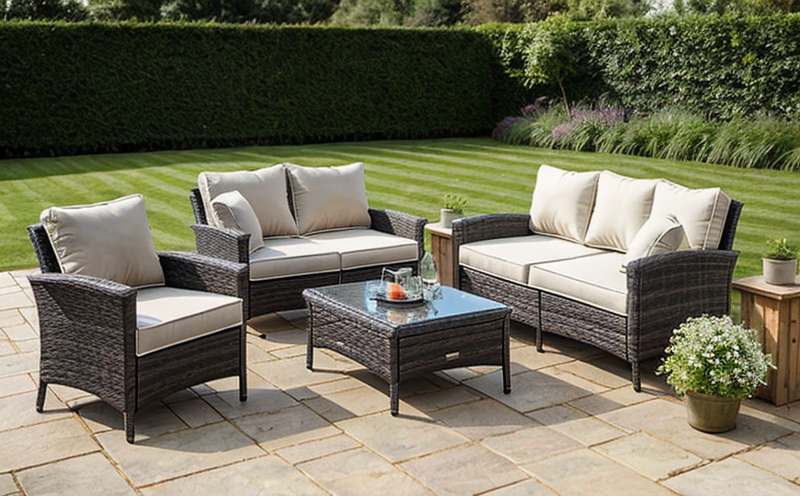DIN EN ISO 9227 Corrosion Testing for Outdoor Metal Furniture Components
The DIN EN ISO 9227 corrosion testing protocol is an internationally recognized standard designed to assess the resistance of metal components used in outdoor furniture against atmospheric corrosion. This test focuses on materials commonly found in garden and patio furniture, where exposure to moisture, UV radiation, and fluctuating temperatures can significantly affect material integrity over time.
The primary goal of this testing method is to ensure that products meet the durability requirements set by industry standards, thereby protecting consumers from potential safety hazards. The test involves subjecting metal specimens to a salt fog atmosphere for extended periods under controlled conditions. Salt fog environments simulate real-world outdoor exposure scenarios accurately.
During the testing process, the specimen's weight loss is measured at regular intervals throughout the exposure period. Additionally, visual inspections are conducted periodically to observe any changes in coloration or surface texture indicative of corrosion. The results provide manufacturers with valuable insights into product longevity and help identify potential areas for improvement.
The DIN EN ISO 9227 test procedure offers several advantages over other forms of accelerated testing methods. For instance, it allows for the evaluation of different coating systems on various substrates under consistent environmental conditions. This consistency ensures that comparisons between products are fair and accurate.
Moreover, this standardized approach helps ensure compliance with international regulations regarding product safety and quality assurance. By adhering to these guidelines, businesses can demonstrate their commitment to producing reliable, long-lasting outdoor furniture solutions.
Understanding the importance of proper material selection for outdoor furniture is crucial in ensuring the longevity of products exposed to harsh environmental factors. Materials like stainless steel, aluminum, or galvanized iron offer superior resistance against corrosion but may not be suitable for all applications due to cost considerations or aesthetic preferences.
To achieve optimal results from DIN EN ISO 9227 testing, careful preparation and handling of specimens are essential steps in the process. Specimens should represent typical configurations found within actual products being tested. Proper cleaning procedures must also be followed before placing them into the salt fog chamber to eliminate any contamination that could skew test outcomes.
In summary, DIN EN ISO 9227 corrosion testing plays a vital role in assessing the durability of metal components used in outdoor furniture. By following this internationally recognized standard, manufacturers can gain valuable insight into product performance and make informed decisions about material choices and design improvements.
Benefits
Adopting DIN EN ISO 9227 corrosion testing brings numerous benefits to manufacturers of outdoor metal furniture:
- Promotes Product Integrity: Ensures that products maintain their structural integrity even after prolonged exposure to challenging environmental conditions.
- Enhances Consumer Trust: Builds confidence among consumers by providing evidence of product reliability and longevity.
- Aids Regulatory Compliance: Helps businesses meet legal requirements related to material safety standards.
- Fosters Innovation: Encourages continuous improvement in design and manufacturing processes through data-driven decision-making.
By embracing this rigorous testing methodology, manufacturers can enhance their reputation while also protecting themselves from potential liabilities associated with defective products.
Industry Applications
| Application Area | Description |
|---|---|
| Garden Furniture | Includes patio chairs, tables, and benches designed for outdoor use. These pieces are frequently exposed to elements such as rain, wind, and sunlight. |
| Patio Seating & Dining Sets | Consists of sets intended for alfresco dining or relaxing outdoors. Components include metal frames, legs, and other structural elements. |
| Garden Benches | Represents stationary seating options typically found in public parks or private gardens. Frames are often made from durable metals such as aluminum or stainless steel. |
| Outdoor Play Equipment | Involves metal structures used for children's play areas, including swings and climbing frames. These installations need to withstand heavy use while remaining safe. |
The DIN EN ISO 9227 test is particularly relevant for these applications because it evaluates the performance of metal components under conditions similar to those encountered in real-world settings. This ensures that manufacturers produce products capable of withstanding long-term exposure without compromising safety or functionality.
Why Choose This Test
- Precision: Provides precise measurement of weight loss and visual inspection data, offering clear evidence of material performance under specified conditions.
- Consistency: Ensures consistent results across different laboratories by adhering to standardized procedures outlined in the DIN EN ISO 9227 document.
- Rigor: Tests materials thoroughly over extended periods, simulating actual outdoor exposure times more accurately than shorter-duration tests.
- Compliance: Helps ensure compliance with international standards and regulatory requirements related to material safety.
- Insight: Offers valuable insights into product performance that can inform design modifications or process improvements.
- Reliability: Guarantees reliable outcomes, enhancing consumer trust in the quality of products offered by manufacturers.
The rigorous nature of DIN EN ISO 9227 corrosion testing sets it apart from other methods available for evaluating metal components used in outdoor furniture. Its ability to provide accurate and consistent results makes it an indispensable tool for ensuring product reliability and durability.





